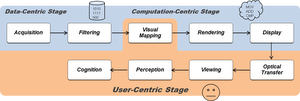Information
- Publication Type: Invited Talk
- Workgroup(s)/Project(s):
- Date: 2013
- Event: SCCG 2013
- Location: Smolenice castle, Slovakia
- Conference date: 2. May 2013 –
Abstract
Visualization algorithms are nowadays formalized in an imperative manner, i.e. the algorithm is explicitly executed on input data and dictates a determined visualization outcome. The efficiency of such an algorithm is measured by means of the computational performance, data-scalability and user studies. In my talk I will speculate on a novel theoretical concept for the development of new visualization methodology that becomes ultimately declarative and algorithm-free, by moving the user study from a validation stage into the center of the iterative design stage. Initial visualization from input data is considered as the first design draft, which will undergo several revisions. This draft can be achieved by executing a traditional imperative algorithm or it can even be hand-crafted by a skilled illustrator. A consequent user study of initial visualization will trigger computational synthesis of a new, quantitatively more effective visualization technique. The visualization designs developed through several iterations of the study-redesign cycle will become declarative, aiming at optimally satisfying the purpose of the visualization, instead of explicit execution of algorithms on the input data. The declarative component will be specified by collected user statistics from completing certain perceptual or cognitive tasks. The user statistics will be analyzed for systematic trends in human perceptual and cognitive performance. These trends will form a basis for visualization redesign. Final satisfactory visualization will evolve over several design iterations.Additional Files and Images
Weblinks
No further information available.BibTeX
@talk{Viola_Ivan_2013_DC,
title = "Declarative Visualization",
author = "Ivan Viola",
year = "2013",
abstract = "Visualization algorithms are nowadays formalized in an
imperative manner, i.e. the algorithm is explicitly executed
on input data and dictates a determined visualization
outcome. The efficiency of such an algorithm is measured by
means of the computational performance, data-scalability and
user studies. In my talk I will speculate on a novel
theoretical concept for the development of new visualization
methodology that becomes ultimately declarative and
algorithm-free, by moving the user study from a validation
stage into the center of the iterative design stage. Initial
visualization from input data is considered as the first
design draft, which will undergo several revisions. This
draft can be achieved by executing a traditional imperative
algorithm or it can even be hand-crafted by a skilled
illustrator. A consequent user study of initial
visualization will trigger computational synthesis of a new,
quantitatively more effective visualization technique. The
visualization designs developed through several iterations
of the study-redesign cycle will become declarative, aiming
at optimally satisfying the purpose of the visualization,
instead of explicit execution of algorithms on the input
data. The declarative component will be specified by
collected user statistics from completing certain perceptual
or cognitive tasks. The user statistics will be analyzed for
systematic trends in human perceptual and cognitive
performance. These trends will form a basis for
visualization redesign. Final satisfactory visualization
will evolve over several design iterations.",
event = "SCCG 2013",
location = "Smolenice castle, Slovakia",
URL = "https://www.cg.tuwien.ac.at/research/publications/2013/Viola_Ivan_2013_DC/",
}


 Paper
Paper
